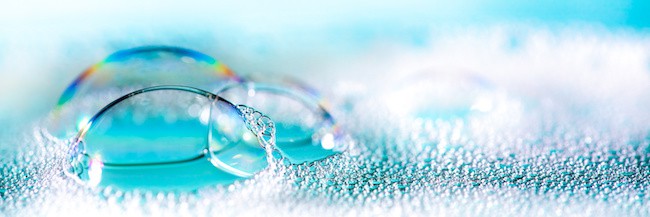
Learn the ABCs of foam innovations, including additives, bio-based building blocks and cooling
Polyurethane foams and their viscoelastic and high-resilience siblings have proven their flexibility in sleep products constructions, ushering in the age of specialty bedding, giving rise to hybrid mattresses and driving the industry-reshaping launch of boxed beds.
These foams have solidified their role throughout the mattress, from sturdy conventional polyurethane foam cores to cushy, enveloping visco comfort layers. Today’s foam suppliers are playing with additives that boost foam benefits — and intrigue consumers — while creating hybrid foams that take the best qualities of PU, visco and HR versions to create new feels and levels of support.
MORE ON THE CORE
Foams, latex and springs — individually or in combination — are at the heart of every mattress. We covered trends and innovations in innersprings in the September issue of BedTimes. In the November issue, we will bring you the latest news about latex.
(There’s plenty of news in latex, too, but here we’re examining polyurethane trends. Look for a deeper dive into latex innovations in the November issue of BedTimes.)
From foamers to bed builders
Perhaps the biggest foam trend has less to do with foam bedding components themselves and more to do with the changing role of foam suppliers, who, along with their sewn cover supplier counterparts, have become bedding manufacturers in their own right.
For some foam suppliers, the vast majority of their business now is producing finished foam beds, typically boxed — and often handling fulfilment, too — mostly for direct-to-consumer e-commerce companies but also for more traditional bedding makers and retailers. Even foamers that still concentrate on pouring say they now offer finished mattresses.

NCFI, which produces both components and finished beds, has opened a wholesale showroom at the Las Vegas Market’s World Market Center to showcase its finished mattresses, including hybrid models, and introduce its foam advances. At the summer show, the company unveiled a new look and lineup for its BedInABox brand, which it bought in 2018. For the BedInABox line, NCFI produces the foam, manufactures the beds, packs and ships them — full service and in-house.
“How we go to market is like most foam companies right now: We make foam for bedding producers and we make finished mattresses,” says Chris Bradley, NCFI executive vice president for consumer products. The company, based in Mount Airy, North Carolina, has a flexible polyurethane foam production center at its headquarters, plus another plant in Hickory, North Carolina, and two others in Dalton, Georgia, and Salt Lake City.
Bradley says producing finished mattresses is helping foam suppliers better understand the needs of mattress manufacturers, retailers and, ultimately, consumers, and is helping to drive foam innovations.
The main part of Latexco’s bedding business continues to be components but the finished mattress segment — in the company’s case aimed at business-to-business customers rather than the direct-to-consumer channel — “is growing every day,” says Brent Limer, chief sales officer for Latexco U.S. Holdings LLC, which has headquarters in Lavonia, Georgia, and another U.S. manufacturing facility in Phoenix. The company offers a variety of polyurethane, visco and high-resilience foams, as well as latex.
Similarly, Future Foam remains first and foremost a foamer, but also builds finished beds to meet customers’ design specifications and offers a private-label, good-better-best boxed program through its plants in California, Massachusetts, North Carolina, Texas and Wisconsin, says Brett Almquist, regional sales manager for the Council Bluffs, Iowa-based company. Future Foam has 25 U.S. facilities, including six pouring plants; a pouring and fabrication plant in China; and a foam recycling facility in Germany.
Future Foam also is developing a proprietary Allay foam line for a top-of-bed program out of its plant in Fullerton, California, pairing mattress toppers and pillows, Almquist says. “It allows customers to customize their entire product line,” he says. “There’s a lot we can do to customize comfort layers and molded pillows — coat them with PCMs (phase-change materials), aerate them with pinholes, infuse them with thermal conductors, and add fragrances like lavender and even coconut.”
United Textiles + Components uses its capabilities in both foam pouring and pocket coil construction to produce finished foam and hybrid beds. Part of its business is serving as a contract manufacturer for U.S-based bedding makers reaching overseas markets, says Pat Flippin, director of sales for UT + C, which has North American offices in Danville, Virginia, and headquarters in Nowe Skalmierzyce, Poland. The company makes a variety of bedding components, and pours conventional polyurethane, HR and visco foams in Poland.
Boxed beds are a driving force
Although mattress companies that specialize in boxed beds are beginning to introduce hybrid models that include both innersprings and foams, the fact that most boxed specialists started with foam-only models created intense competition to come up with new foam formulations they could use to differentiate their products from others, foam suppliers say.
And, from a practical standpoint, Almquist says, mattresses that will be compressed, rolled and boxed need to be made with foams dense enough and resilient enough to withstand that type of handling yet bounce back quickly and completely when the consumer unpacks the bed at home.
As Limer explains: “The boxed-bed movement is changing the way everyone is designing components for boxed beds. If you make components that can’t be compressed and rolled, you’re limiting your reach, so almost everything you roll out needs to be boxed-bed compatible.”
Bradley agrees. “For e-commerce, the foams have to be durable enough to withstand roll packing,” he says. “Those customers also want foam that can help tell a slightly different story than what else is out there, and they want a competitive advantage in terms of price, something that will take a dollar or two out of their build.”
The demands of e-commerce boxed-bed specialists have begun to have an effect on the expectations of mattress manufacturers selling to brick-and-mortar retailers, as well, Bradley says.
“The brick-and-mortar guys, especially those making mostly innerspring mattresses, have traditionally looked at foams as a commodity and have been strictly price driven,” he says. “But now we’re seeing them ask the same questions as the e-commerce guys: What’s new? What’s different?”
So, what is new? What is different? Let’s look at some of the most significant trends in foam components.
“A” is for additives
One of the reasons that visco foam has been so popular in bedding constructions is not just its soft, conforming feel, but the fact that it’s accepting of a variety of additives, Flippin says.
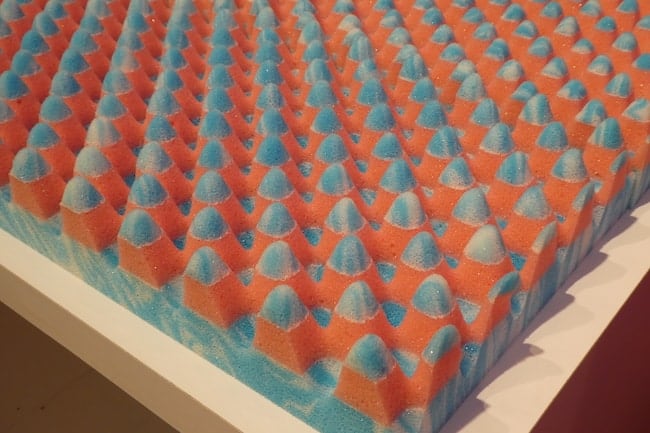
“Visco has been a very flexible product because of the components that can be added to it. That has given it longevity in terms of marketing stories, and marketing stories have always been important in this industry,” Flippin says. “Visco really is responsible for the rise of foam (in bedding). Before it, there hadn’t been a lot of changes in polyurethane, except convolution and contour cutting.”
For the most part, newer additives for bedding foams are intended to help regulate mattress temperature, reduce moisture and absorb odors to keep the mattress hygienic. Other ingredients are linked to health claims, such as reducing inflammation or improving circulation in sleepers.
“One of the trends I see is thermal conductors being added to foams — copper, gold, silver, platinum,” Almquist says. “And we’re starting to do more with graphite, which helps with cooling, and activated charcoal, which has odor inhibitors.”
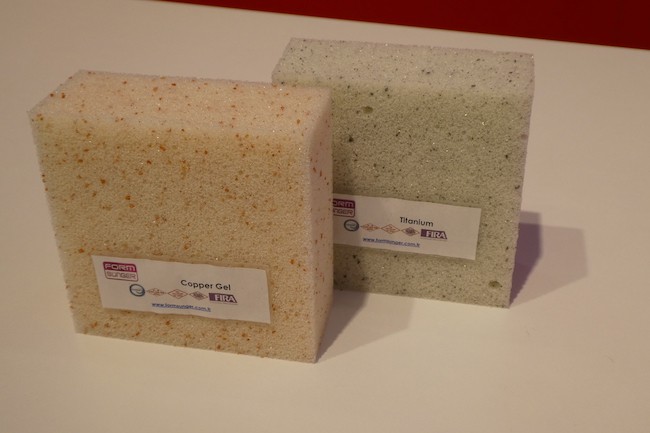
At Interzum Cologne in May, Form Sunger, based in Kayseri, Turkey, introduced new memory foams containing copper and titanium, as well as graphite. Latexco also offers foams with a number of different additives, including graphite, aluminum, copper, cooling PCMs, pumpkin seed oil and others. Some foamers are investigating incorporating CBD oil into foams or using it as a topical coating. (Cannabidiol is extracted from the marijuana or hemp plant, and, according to the World Health Organization, causes neither a high nor leads to dependence. Its proponents claim health benefits such as pain reduction.)
NCFI highlighted its copper-infused memory foam at the Summer Las Vegas Market, where it showed a finished hybrid bed with copper foam in the comfort layer, copper coils in fabric pockets and copper fibers in the ticking so that “the sleeper is getting all of the copper’s benefits,” Bradley says. Copper has anti-microbial properties and also is said to improve circulation and reduce inflammation.
Bedding makers like foam additives not only for their benefits to sleepers but for the ways they allow them to distinguish their products, Almquist says. But Future Foam is conservative when it comes to touting the properties of additives, recognizing that the placement of foam layers in a finished mattress can affect the efficacy of ingredients, he says. Better to let mattress manufacturers and retailers tout the benefits and features of a complete system.
“One of the new products we have is a copper additive, and manufacturers have had success with it,” Almquist says. “It’s in a gel memory foam so they can market the copper, gel or memory foam features (separately) and utilize its features and benefits in various beds in their lines.”
To meet bedding manufacturers’ needs for customization, Latexco invites customers to its Latexco Academy, where they can experiment with different foam builds until they hit on just the right combination.
“That’s one of our strengths,” Limer says. “We have very low minimum orders, and it doesn’t cost us a lot to do full trials. It’s kind of like being in the kitchen: If you want a little more ‘salt’ or ‘pepper,’ we can add it.”
Flippin says in the push to distinguish themselves and their bedding lines, mattress manufacturers want to incorporate unique components and patented technologies. “They want to make sure their components are proprietary and want exclusive manufacturing arrangements,” he says.
“B” is for bio-based
In an effort to make polyurethane foams more sustainable, some foamers are adding bio-based polyols to the mix. The greener foams are particularly popular in Europe and, at Interzum Cologne, a number of European-based foam suppliers introduced such foams, including Form Sunger.
Arif Emre Olmeztoprak, Form Sunger international sales and marketing manager, says more than half of the petrochemicals in the company’s new line of foams have been replaced with bio-based polyols. The versatile foams are available in various weights and densities, and are suitable for use in mattress cores, transition layers and comfort layers, he says.
Also at the spring show, polyol supplier Cargill, headquartered in Wayzata, Minnesota, promoted its BiOH line of bio-based polyols, including the new BiOH 5556, which the company says can replace 100% of the petro-polyols in foam.
Taking a different tack, FoamPartner, headquartered in Wolfhausen, Switzerland, has created a line of more sustainable HR foams by using less petro-polyols. The company showcased the new EvoPoreVHRC in Cologne, saying it uses 30% less feedstock to yield durable, long-lasting yet lighter weight foam.
“C” is for cooling
“We’re still seeing the cooling trend,” Limer says. “People are searching for true, demonstrative results and a cool to the touch feeling.”
Foam suppliers have a number of ways to add cooling properties, including chemistry that creates a more open-celled structure. They also can use mechanical means, such as contour cutting waves and channels or incorporating pinholes and perforations, all of which help move air throughout the mattress. And, by their very nature, PCMs and additives like gel help regulate foam temperatures.
“We’re always trying to drive airflow,” Almquist says. “If you can do it through the foam chemistry, you don’t have to do a secondary process of contour cutting. Our topical gel technology, FutureGel, is loaded with PCMs that we can apply directly to the surface that, when applied to the comfort layer, aids in cooling over the course of the night.”
In the spring, Form Sunger unveiled a colorful triple-layer foam comfort layer. The update on the classic egg-crate design was created with cooling in mind: cooling gel layers sandwich an open-cell memory foam in the middle.
For several years, cooling gel memory foam was a key differentiator for some mattress makers, Almquist says, “But it’s not anymore. It’s almost expected to be there. It’s like memory foam itself used to be: Gel is kind of everywhere now and is no longer considered a premium, exclusive product; however, Future Foam has brought it to the sleep surface.”
Bradley agrees that given the preponderance of gel foams in the marketplace, mattress makers are looking for other ways to cool beds. “There’s no lack of efficacy for gel foams and ‘cool’ is still a huge word in bedding, but we’re seeing PCMs and textile technologies carry more of the mantle for cooling,” he says.
Limer sees foam suppliers and mattress producers “looking for different options to add cooling to the mattress to guarantee a full night’s cooling experience.” Latexco is using carbon fiber technology for cooling. The carbon fiber additive can be incorporated into all grades of Latexco’s visco foams and into latex, as well, he says.
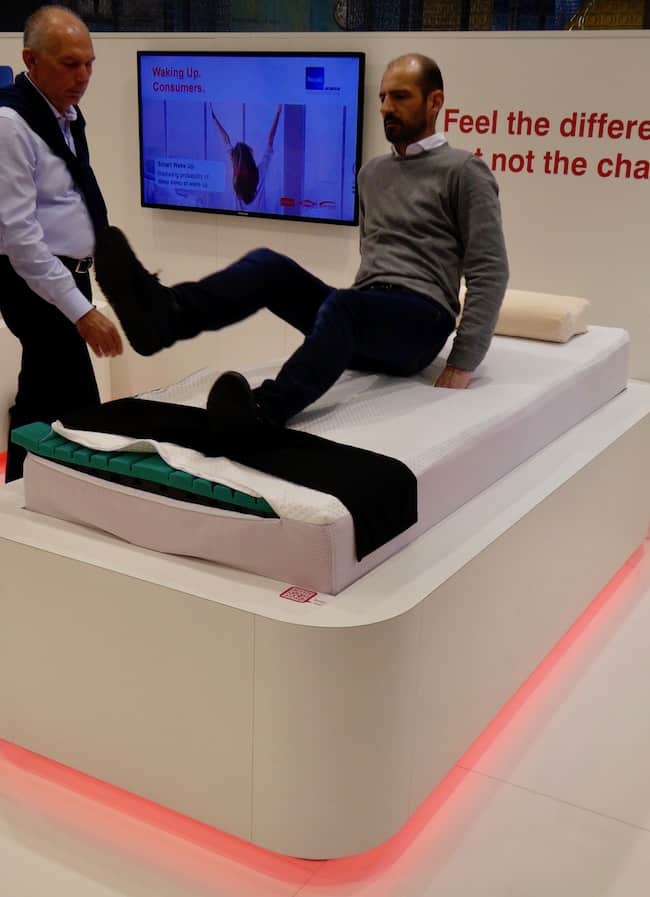
At Interzum Cologne, FoamPartner took temperature regulation to a new level, showing an adjustable “thermodynamic” foam mattress created in partnership with Dow Comfort-Science, a Dow division headquartered in Midland, Michigan, and foamer Variowell Development GmbH, based in Münster, Germany. The bed uses a technology called Teccio.science to change the comfort of the bed by ever-so-slightly warming or cooling the foam through an electronic low-voltage control unit regulated by a smartphone app.
“C” is for constructions, too
To create new feels, bedding manufacturers continue to experiment with how they layer foams in mattress constructions.
Limer says memory foams still tend to be used foremost in top comfort layers but also are appearing in transition layers. “Some people don’t like the ‘dead’ feel of memory foam. Over the last couple of years, we’ve found that visco makes a good transition layer and provides a different feel than when in the top layer,” he says.
Almquist also sees more use of visco in transition layers and points to himself as another example of why. “Visco has a nice feel and a nice hand and people like the feel in the showroom, but it may not have the support. If a guy like me — a little over 6 feet, 240 pounds — lies down on an inch or two of visco, it doesn’t really support me. I hit the transition layer and miss the benefits of the visco,” he explains.
Future Foam is among the foamers experimenting with formulations to create components that exhibit the best characteristics of traditional polyurethane, visco and HR foams, as well as latex. The company offers a gel foam with synthetic latex that provides a latexlike feel at a lower cost than traditional latex. And Future Foam’s HyPURgel pairs the conforming softness of visco with the “support and pushback” of an HR foam, plus has excellent airflow, Almquist says.
“When you put HyPURgel in the top layer, it is temperature and pressure neutral, so it helps spread body weight and you really feel the conforming aspect of the foam,” he says. “It’s a neat feel.”

At the Summer Las Vegas Market, NCFI showed its family of PUL foams, “a group of foams that mimic or exceed the properties of latex but at a lesser cost and, we believe, a better performance,” Bradley says.
“They’re for customers who want the latex feel and bounce but want CertiPUR-certified foams,” he says, adding that all NCFI bedding foams have CertiPUR certification.
Latexco’s Flofom (named for the floating feeling it provides to sleepers) combines the pressure-relieving characteristics of visco with the elasticity of an HR foam, Limer says. And the company has an interesting, yet unnamed polyurethane foam in development.
“Now we’re looking at what is the next category of foam,” Limer says. “It’s a very soft foam but also very supportive and it has a high rate of airflow. We’ve been getting good feedback from customers.”
CertiPUR-US Strengthens Program
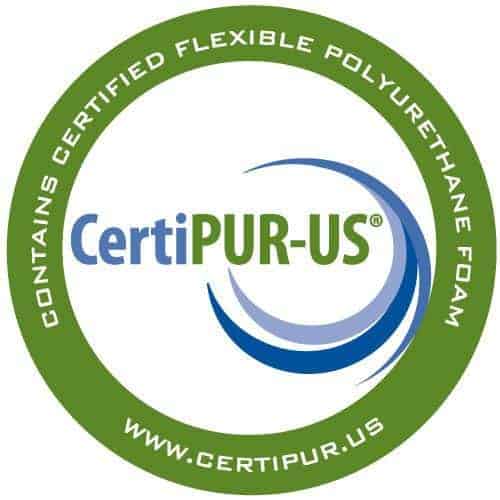
CertiPUR-US, a polyurethane foam certification program now in its 11th year, continues to evolve and expand. Earlier this year, the program added a requirement for bedding manufacturers and retailers that offer products containing CertiPUR-US-certified foams to take a short course in order to be registered with the program. More recently, CertiPUR-US announced that metals testing protocols to meet its certification standards would change to align with the U.S. Consumer Product Safety Commission’s preferred methods.
CertiPUR-US is administered by the nonprofit Alliance for Flexible Polyurethane Foam, headquartered in Rochester Hills, Michigan. Through the program, foam producers submit their foam for evaluation and testing by independent, accredited laboratories. To be CertiPUR-US certified, foams must be made without ozone depleters; PBDEs, TDCPP, TCEP and certain other flame retardants; formaldehyde; mercury, lead and other heavy metals; phthalates regulated by the CPSC; and must have low VOC emissions for indoor air quality (less than 0.5 parts per million). More than 50 foam producers offer certified foams, or foam families, through the program, says Helen Sullivan, CertiPUR-US communications counsel. Conventional polyurethane slabstock, memory foams and molded foams are among those eligible for testing and certification.
Beginning Jan. 1, 2020, CertiPUR-US is changing its criteria for metals testing from the current extraction method to a digestive method preferred by the CPSC. With the change, CertiPUR-US certification will meet or exceed the current ASTM F963-17 toy specification (Section 8.2.1), Sullivan says. At the same time, the program is including barium as a metal to be analyzed under the CertiPUR-US standard, and also is adding Consumer Product Safety Commission Improvement Act annual testing for lead as part of its criteria for certification. (CertiPUR-US’s “Metals of Concern” as of Jan. 1, 2020, are antimony, arsenic, barium, cadmium, chromium, lead, mercury and selenium.)
Sleep products manufacturers who incorporate CertiPUR-US-certified foams into their mattresses, toppers and pillows and retailers who sell products containing certified foams cannot use the CertiPUR-US name or logo in marketing or advertising without registering — and “more than 1,000” manufacturers, retailers and brands have registered and are listed on its website, CertiPUR.us., Sullivan says. There is no cost to register, but verification documents and an agreement to adhere to the program’s terms of use are required. To ensure that consumers are getting accurate information about CertiPUR-US-certified foams, registered manufacturers and retailers send any packaging or marketing materials to CertiPUR-US for review.
In 2017, CertiPUR-US created a free, 20-minute online certificate course to educate retail sales associates about the certification program. More than 2,000 people already have taken the course, and CertiPUR-US now is requiring at least one person at every registered manufacturer and retailer to complete the online class, available at CertiPUR.us/CertificateCourse.
“We want people to buy products containing certified foams, but we don’t want companies to exaggerate or provide misinformation about what the rigorous certification means,” Sullivan says. “The online certificate course educates and gives people tips to talk accurately about the program. We encourage RSAs, marketing people and customer service personnel to take the course and now are mandating that someone from every company registered with us complete it.”
CertiPUR-US also is embarking on a robust national media campaign that will weave messages about certified foams in with other sleep, health and safety tips, Sullivan says.
Barbara T. Nelles contributed to this report.
Finding foamers
To find foamers and foam bedding components, check the BedTimes Supplies Guide, printed annually in the December issue of BedTimes and also available online.





